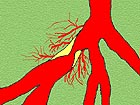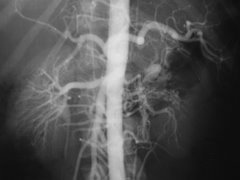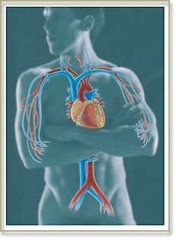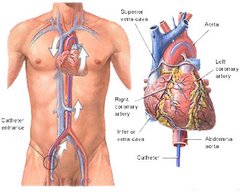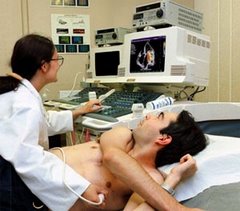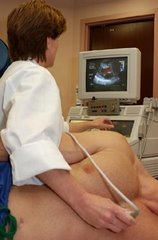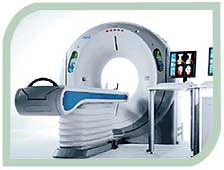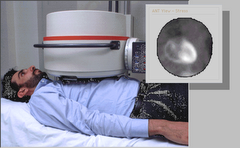Many parts of this story validate what noninvasive cardiologist have felt for a long time, too many people undergo Coronary Artery Bypass Graft Surgery. Perhaps in time, the 64-Line CT will replace the angiogram. For now, implore insurance companies to start covering it as a billable cost. It is a lot less expensive than a CABG
By Alan Bavley
McClatchy Newspapers
(MCT)
KANSAS CITY, Mo. - High cholesterol. High blood pressure. Years of smoking. It's not surprising that a doctor told Stephen Matthews to get his heart checked.
What's really amazing is how Matthews had it done.
For about 10 seconds, Matthews lay still as a computed tomography scanner took X-ray pictures of his heart. Not just any CT scanner, but a new 64-slice CT scanner, one of the hottest pieces of medical hardware on the market.
There on a computer screen at the University of Kansas Hospital was Matthews' heart in vivid colors, every detail of muscle and arteries and surrounding anatomy rendered in almost photographic detail.
This is medical technology on steroids. It's expensive - as much as $1,000 to $2,000 per procedure - it produces gee-whiz results, and it is almost inevitable that it will be widely used before researchers can fully judge its effectiveness.
Hundreds of hospitals and clinics have snatched up the $1.8 million scanners since 2004, when the Food and Drug Administration approved them for use.
For the medical industry, the adoption rate is something akin to the way consumers embraced DVD players.
Some doctors already have expressed concern that the use of 64-slice scanners may be outrunning medical knowledge about the devices.
The scans can detect tumors and other anomalies so minute that doctors are unsure whether they even need to treat them. And used inappropriately, scans would needlessly expose patients to substantial doses of radiation.
"It's exciting. There's a lot of expectation. But you want to be careful about how you use it," said radiologist Udo Hoffmann of Harvard University Medical School.
Experts say 64-slice CT has the potential to revolutionize many fields of medicine, from assessing the injuries of trauma patients to finding tumors to plotting surgeries.
But the most radical transformation may come in the way doctors evaluate patients such as Matthews for coronary heart disease.
"Cardiac CT is the killer application," said Elliot Fishman, a 64-slice CT scanner expert at Johns Hopkins University. "With that, we change how medicine is practiced."
Until 64-slice CT, the only certain way to tell whether a patient's coronary arteries were blocked was with a costly, invasive technique called angiography. In it, doctors snake a catheter from a blood vessel in the groin up to the heart, then inject dye into the coronary arteries and watch the results on an X-ray screen.
Nearly 1.5 million patients undergo angiography in the U.S. each year. Many discover problems that may require interventions such as bypass surgery. But in nearly a third of the cases, the results turn out to be normal.
Doctors hope that many of these relatively healthy patients can be ruled out if they get CT scans first.
That would save patients from the cost of angiography - which averages nearly $10,000 at the University of Kansas hospital, for example. Patients also would avoid the small, but real, risks of angiography: a blood clot or torn artery.
Patients still would have to undergo angiography if their CT scans do not show that their arteries are clear.
"You get a lot of people with chest pains, short of breath. We've always wanted to do noninvasive coronary artery imaging, but we didn't have the tools to do it," said radiologist Louis Wetzel, who runs KU's heart scan program with cardiologist Thomas Rosamond.
In a fraction of a second, the new CT scanners take 64 X-ray images, each a separate "slice" of the body as thick as about five pieces of notebook paper. That is several times the number of images taken by the 4- and 16-slice CT scanners that were state-of-the-art just a few years ago.
After the scanner has made multiple passes around the patient's body, computers assemble the data into images of the heart's exterior and interior.
The higher resolution and faster speed of the new scanners make it possible for the first time to view a beating heart without blurring.
Some studies have found that 64-slice CT can rule out coronary heart disease with 99 percent accuracy.
"Neither of us in our lifetimes thought this would happen," Wetzel said. "Now we can see tiny little vessels. We're really amazed."
Wetzel and Rosamond use the scanner when patients with chest pains or risk factors for heart disease have ambiguous results on another key screening tool, a treadmill stress test.
The results can be unpredictable. A 67-year-old man, a healthy-looking avid tennis player, turned out to have a severely blocked artery; a 73-year-old man with diabetes had a normal scan.
Doctors gave Matthews, a banker from LaCygne, Kan., in his early 60s, the option of angiography or CT. A scan made more sense, he said.
"If I could go through this deal without anyone cutting on me, it will be all right," Matthews said.
When it was over, Matthews was relieved. The scan showed no blockages in his coronary arteries. "Nothing unusual for an old (guy) like me," he said.
Rosamond and Wetzel have been getting urgent requests from KU emergency-room doctors to evaluate their heart patients.
Chest pains account for as many as 8 million trips to emergency rooms every year in the U.S. Nearly half these patients are admitted overnight to hospitals to undergo tests and angiography. Many of these hospitalizations turn out to be unnecessary.
So far, the KU doctors don't think they have had enough experience with the scanner to use it on ER patients.
"The stakes are huge - if you decide wrong and send them home with a heart attack, that's a million-dollar lawsuit," Rosamond said.
Other hospitals are testing the scanner in their ERs.
At the Hospital of the University of Pennsylvania in Philadelphia, low-risk patients who come to the ER with chest pains get preliminary tests and a CT scan. If the results are negative, the patients are discharged.
About 85 percent to 90 percent of patients who have gotten the scans have been able to go home, said radiologist Harold Litt.
Researchers check on these patients 30 days later.
"Nobody we've said was negative has ended up having a cardiac problem," Litt said. "That's the sort of thing that makes physicians more comfortable."
CT scans may be fine for low-risk patients who come in through the ER, said cardiologist David Marks of the Medical College of Wisconsin, one of the first doctors to use a 64-slice scanner.
Higher-risk patients who are destined for bypass surgery or angioplasty to open blocked arteries still need the demonstrated reliability of angiography to determine the extent of their disease.
"We've yet to really prove in all patient populations the diagnostic effectiveness of this (CT) test," Marks said.
That lack of evidence is holding back insurance companies' approval of 64-slice CT scans.
Medicare is leaving coverage decisions up to the local insurance companies that process its claims.
Most private insurance companies cover the scans only on a case-by-case basis, said Rosamond of KU. Many patients are being turned down.
"We have a lot of patients who would benefit but decide against it because of the out-of-pocket costs," he said. "I think what insurers are afraid of is physicians will use it as a screening test inappropriately for everybody and they'll be flooded with claims."
But it could be hard to keep the floodgates closed. Widespread adoption of 64-slice CT heart scans is likely to happen before all the evidence is in, said Hoffmann of Harvard.
"How things are applied isn't always dictated by science," he said. "Medical opinion is like a big ship; once it is moving in one direction, it's hard to steer it in a different direction."
 2.0 mg/dL or an increase in the serum creatinine level of
2.0 mg/dL or an increase in the serum creatinine level of  0.7 mg/dL from preoperative to maximum postoperative values. PRD occurred in 171 (7.7%) of the patients studied; 30 of these (18%, or 1.4% of all study patients) required dialysis. The mortality rates were 0.9% among patients who did not develop PRD, 19% in patients with PRD who did not require dialysis, and 63% among those who required dialysis.
0.7 mg/dL from preoperative to maximum postoperative values. PRD occurred in 171 (7.7%) of the patients studied; 30 of these (18%, or 1.4% of all study patients) required dialysis. The mortality rates were 0.9% among patients who did not develop PRD, 19% in patients with PRD who did not require dialysis, and 63% among those who required dialysis.






